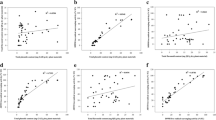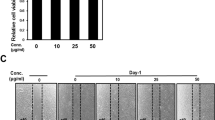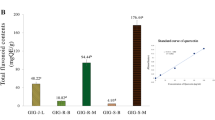Abstract
Oxidative stress has been postulated to contribute significantly to the accelerated accumulation of advanced glycoxidation endproducts (AGEs) in collagen, which is implicated in the process of skin aging. Effectiveness of Actinidia chinensis, commonly called gold kiwifruit, in counteracting skin aging was investigated. Firstly, primary crude 70% ethanolic extracts of whole A. Chinensis, pulp, and rind were screened for their in vitro antioxidant activities and anti-glycation activity by using 1,1-diphenyl-2-picrylhydrazyl (DPPH), Ferric Reducing Antioxidant Power (FRAP) assay, and bovine serum albumin-derived glycation model. Result indicated that rind portion exhibited significantly (p<0.05) high antioxidant activity as well as high phenolic and flavonoid contents compared to those of pulp and whole A. Chinensis. Thus, rind was selected for further fractionated with hexane, chloroform, ethyl acetate, and butanol. Among these solvent fractions, A. chinensis rind ethyl acetate (ACRE-E) had the greatest radical-scavenging activity and reducing power, comparable to standard antioxidant, vitamin C. Immunofluorescence staining was used to determine AGEs distribution in glycated collagen matrix. ACRE-E inhibited formation of 67% AGEs. High Performance Liquid Chromatography analysis revealed phenolic compound of ACRE-E as quercetin-3-rhamnoside. High antioxidant and anti-glycation activities of ACRE-E in glycated collagen model indicate its contribution to anti-aging process. A. chinensis rind, previously considered as a byproduct, may have potential as a low-cost raw material for cosmetic and pharmaceutical industries.
Similar content being viewed by others
References
Arumugam P, Ramamurthy P, Santhiya ST, and Ramesh A (2006) Antioxidant activity measured in different solvent fractions obtained from Mentha spicata L.: An analysis by ABTS(·+) decolorization assay. Asia Pac J Clin Nutr 15(1), 119–124.
Baynes JW(1991) Role of oxidative stress in development of complications in diabetes. Diabetes 40(4), 405–412.
Choi SY, Jung SH, Lee HS, Park KW, Yun BS, and Lee KW (2008) Glycation inhibitory activity and the identification of an active compound in Plantago asiatica extract. Phytother Res 22(3), 323–329.
Fiorentino A, D’Abrosca B, Pacifico S, Mastellone C, Scognamiglio M, and Monaco P (2009) Identification and Assessment of Antioxidant Capacity of Phytochemicals from Kiwi Fruits. J Agric Food Chem 57, 4148–4155.
FiorentinoA, Mastellone C, D’Abrosca B, Pacifico S, Scognamiglio M, Cefarelli G, Caputo R, and Monaco P (2009) delta-Tocomonoenol: A new vitamin E from kiwi (Actinidia chinensis) fruits. Food Chem 115(1), 187–192.
Glenn JV and Stitt AW (2009) The role of advanced glycation end products in retinal ageing and disease. Biochim Biophys Acta Gen Subj 1790(10), 1109–1116.
Kim MK, Lee HS, Kim EJ, Won NH, Chi YM, Kim BC, and Lee KW (2007) Protective effect of aqueous extract of Perilla frutescens on tert-butyl hydroperoxide-induced oxidative hepatotoxicity in rats. Food Chem Toxicol 45(9), 1738–1744.
Lee HS, Jung SH, Yun BS, and Lee KW (2007) Isolation of chebulic acid from Terminalia chebula R. and its antioxidant effect in isolated rat hepatocytes. Arch Toxicol 81(3), 211–218.
Lyons TJ (1993) Glycation and oxidation: A role in the pathogenesis of atherosclerosis. Am J Cardiol 71(6), 26B-31B.
Maisuthisakul P and Gordon MH (2009) Antioxidant and tyrosinase inhibitory activity of mango seed kernel by product. Food Chem 117(2), 332–341.
Maksimovic Z, Kovacevic N, Lakusic B, and Cebovic T (2010) Antioxidant activity of yellow dock (Rumex crispus L., Polygonaceae) fruit extract. Phytother Res 25, 101–105.
Maksimovic Z, Malencic D, and Kovacevic N (2005) Polyphenol contents and antioxidant activity of Maydis Stigma extracts. Bioresource Technol 96(8), 873–877.
Pageon H (2010) Reaction of glycation and human skin: The effects on the skin and its components, reconstructed skin as a model. Pathol Biol 58(3), 226–231.
Pageon H, Techer MP, and Asselineau D (2008) Reconstructed skin modified by glycation of the dermal equivalent as a model for skin aging and its potential use to evaluate anti-glycation molecules. Exp Gerontol 43(6), 584–588.
Rassam M and Laing W (2005) Variation in ascorbic acid and oxalate levels in the fruit of Actinidia chinensis tissues and genotypes. J Agric Food Chem 53(6), 2322–2326.
Rice-Evans CA, Miller N, and Paganga G (1997) Antioxidant properties of phenolic compounds. Trends Plant Sci 2(4), 152–159.
Rout S and Banerjee R (2007) Free radical scavenging, anti-glycation and tyrosinase inhibition properties of a polysaccharide fraction isolated from the rind from Punica granatum. Bioresource Technol 98(16), 3159–3163.
Sarikurkcu C, Tepe B, Semiz DK, and Solak MH (2010) Evaluation of metal concentration and antioxidant activity of three edible mushrooms from Mugla, Turkey. Food Chem Toxicol 48(5), 1230–1233.
Steenvoorden DPT and van Henegouwen GMJB (1997) The use of endogenous antioxidants to improve photoprotection. J Photoch Photobio B 41(1–2), 1–10.
Tanaka J, Shan SJ, Kasajima N, and Shimoda H (2007) Suppressive effect of defatted kiwi fruit seed extract on acute inflammation and skin pigmentation. Food Sci Technol Res 13(4), 310–314.
Vierkotter A, Ranft U, Kramer U, Sugiri D, Reimann V, and Krutmann J (2009) The SCINEXA: A novel, validated score to simultaneously assess and differentiate between intrinsic and extrinsic skin ageing. J Dermatol Sci 53(3), 207–211.
Wang KJ and Li N (2007) Antioxidant phenolic compounds from rhizomes of Curculigo crassifolia. Arch Pharm Res 30(1), 8–12.
Author information
Authors and Affiliations
Corresponding author
Rights and permissions
About this article
Cite this article
Lee, Y., Hong, CO., Nam, MH. et al. Antioxidant and glycation inhibitory activities of gold kiwifruit, Actinidia chinensis . J. Korean Soc. Appl. Biol. Chem. 54, 460–467 (2011). https://doi.org/10.3839/jksabc.2011.071
Received:
Accepted:
Issue Date:
DOI: https://doi.org/10.3839/jksabc.2011.071




